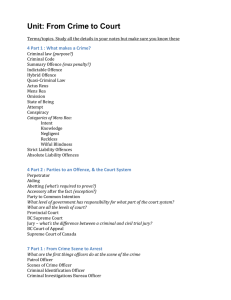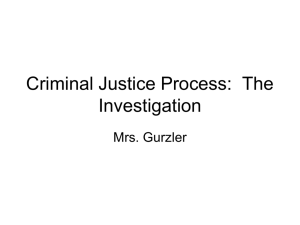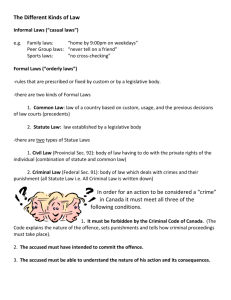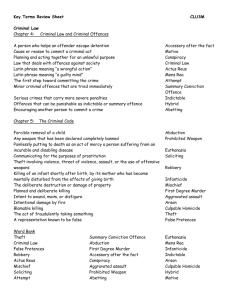Arrest and Detention - Steve Summerville
advertisement
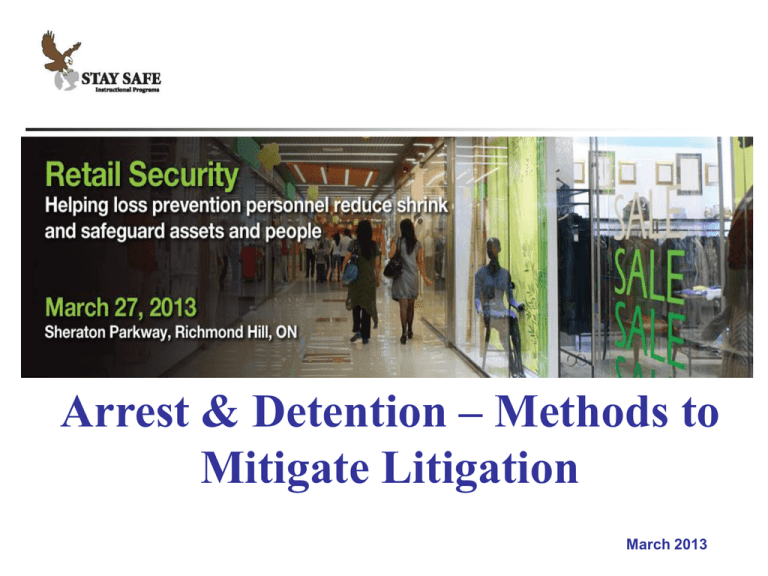
. Arrest & Detention – Methods to Mitigate Litigation March 2013 Seminar Topics • • • • • • • Definition of Risk. Risk Management. Duty of Care. Restraint – Industry Standards. Comparable Standards. Police Use of Force – Principles. Restraint – Principles. www.staysafeip.com March 2013 Seminar Topics • • • • • • Security – Use of Force Application. Restraint in the Workplace. Considerations of Restraint. Tort Considerations. Restraint Training Considerations. Citizen’s Arrest & Self-Defence Act (In Force – March 11, 2013). www.staysafeip.com March 2013 Definition of Risk • Risk = the likelihood of harm or loss • Risk is calculated by multiplying: • likelihood that a harm-causing event will occur (foreseeable risk) x • the organization’s degree of vulnerability to that harm x • the amount/category of harm that would be caused by that event (Ontario Trial Lawyers Association) www.staysafeip.com March 2013 Definition of Risk Management • The proactive and systematic application of the management/ownership policies, procedures and practices to the tasks of identifying, analyzing, evaluating, controlling, monitoring and responding to RISK. • Management of Foreseeable www.staysafeip.com Risk. March 2013 Duty of Care • Particular standard of conduct toward another person • With respect to “duty of care” a person may be subject to liability and accountability especially when injury is sustained • Due diligence represents a reasonable standard of care = “industry related practices” www.staysafeip.com March 2013 Restraint – Industry Standards • With Respect to Security, there is no industry standard featuring “physical skills” or training designed/intended to provide the requisite skills respecting the physical aspects of arrest and/or detention. • Training representing arrest, detention and restraint that is intended for the security industry is provided through non-regulated programs that is best characterized as “industry best practices”. www.staysafeip.com March 2013 Comparable Standards • Law Enforcement (policing & corrections). • Health Care (patient restraint). • Police Services governed by the Ontario Police Services Act. • Ontario Regulation #926 mandates the following: - Shall not use force on another person unless first successfully completed a training course on the use of force. www.staysafeip.com March 2013 Comparable Standards • Ontario Regulation #926 mandates the following: - Training to include: legal requirements, the exercise of judgment, safety and theories relating to the use of force and practical proficiency. • Ontario Police College provides a 13-week training program v. a one-week training program for security. www.staysafeip.com March 2013 Police Use of Force - Principles • The application of physical or implied force intended to control a person. • For a lawful purpose. • Using reasonable response options. • That is proportional to the person’s behavior(s). • Given the officer’s perceptions within the totality of the circumstances. www.staysafeip.com March 2013 Restraint - Principles • The use of restraining devices (handcuffs) is based on a persons judgment and discretion that the circumstances warrant their application. • The use of handcuffs must be reasonable and justified. • Restraints may be used to prevent the escape of an arrested person. www.staysafeip.com March 2013 Restraint - Principles • Restraints may be used when a person has been arrested for an offence involving violence. • Restraints may be used when a person demonstrates or possesses physical skills and abilities or superior strength. • Restraints may be used to prevent the destruction of evidence. www.staysafeip.com March 2013 Restraint in the Workplace • Need to restrain and/or remove individuals? • Need to detain and/or arrest individuals? • Requirement for staff to engage? • Requirement for staff to utilize restraints? • Risk to attempting physical control without the use of restraints? www.staysafeip.com March 2013 Purpose Of Restraint To Control a Subjects Ability to Resist, Escape, Harm Themselves or Others and to Preserve Evidence. www.staysafeip.com March 2013 Considerations of Restraint • • • • • • • Perception of violence in the workplace? Occupational Health & Safety Liability? Bill 168 Training Compliant? Federal Statute Authority? Occupier Liability Act Requirements? Tort (Litigation) Liability? Court defensible response? www.staysafeip.com March 2013 Tort Considerations • • • • Printed Job/Employment Descriptions? Policies Respecting Restraint/Detention? Equipment to Protect (Handcuffs)? Policies Respecting Subject Control and/or The Removal of Patrons? • Proof of Training? • Proof of Testing? • PSISA Compliance? www.staysafeip.com March 2013 Restraint Training Considerations • • • • • • • Use of force principles. Legal authorities. Crisis / De-escalation training. Effective communications training. Documentation principles. Ethical Means to Restrain – Handcuffs. Report writing, note taking, evidence and crime-scene protection. www.staysafeip.com March 2013 The Citizen’s Arrest & Self-Defence Act • Introduced and received first reading on February 17th, 2011. • The Bill amends the Criminal Code with respect to private citizen (and security) powers of arrest, the ability to use force (self-defence), and the defence of property. • Royal Assent – May 1, 2012. • Into Force – March 11, 2013. www.staysafeip.com March 2013 The Citizen’s Arrest & Self-Defence Act • Section #494(2) of the Criminal Code is amended and now permits a person to make an arrest “within a reasonable time after the offence is committed”. • An arrest can only be made only if the person making the arrest believes on reasonable grounds that is not feasible in the circumstances for a peace officer to make the arrest. www.staysafeip.com March 2013 The Citizen’s Arrest & Self-Defence Act • The Bill amends the Criminal Code to simplify the provisions respecting the defence of property and persons. • Sections #34-#37 of the Criminal Code are repealed and replaced with a single “selfdefence” provision (new section #34) that applies to any offence. www.staysafeip.com March 2013 The Citizen’s Arrest & Self-Defence Act • Sections #38-#42 of the Criminal Code are repealed and replaced with a single “defence of property” provision (new section #35). • The new section eliminates the current distinction between the defence of personal and real property. www.staysafeip.com March 2013 Authorized by Law • Where a statute or act allows a person to follow a course of action. • Not to be confused with operational policy, procedure or best practices. www.staysafeip.com March 2013 In Good Faith • With sincere and honest intention. • Free from any knowledge of bias or dishonesty. • A requirement to lawfully apply force. www.staysafeip.com March 2013 Reasonable Grounds • A set of facts or circumstances (the situation) that would cause a person of ordinary care and judgment to make a decision that goes beyond mere doubt or suspicion. • Your personal belief system. • A basis to describe perception. www.staysafeip.com March 2013 Reasonable Time • Not yet clearly defined. • Has been interpreted in the US Courts as: • “the amount of time necessary to do whatever was required to be done as soon as the circumstances reasonably permitted”. www.staysafeip.com March 2013 Revised Citizens Powers of Arrest Sec. 494.(1) Arrest without warrant Anyone may arrest without warrant: (a) A person whom he finds committing an indictable offence or; (b) A person who on reasonable grounds he believes (i) has committed a criminal offence and (ii) is escaping from/freshly pursued by persons who have lawful authority to arrest. www.staysafeip.com March 2013 Sec. 494.(2) Arrest by owner The owner or a person in lawful possession of property, or a person authorized by the owner or by a person in lawful possession of property, may arrest a person without a warrant if they find them committing a criminal offence on or in relation to that property and: (a) They make the arrest at that time; or www.staysafeip.com March 2013 Sec. 494.(2) Arrest by owner (b) they make the arrest within a reasonable time after the offence is committed and they believe on reasonable grounds that it is not feasible in the circumstances for a peace officer to make the arrest. www.staysafeip.com March 2013 Sec. 494.(3) Delivery to peace officer Anyone other than a peace officer who arrests a person without a warrant shall forthwith deliver the person to a peace officer. www.staysafeip.com March 2013 Sec. 494.(4) Delivery to peace officer For greater certainty, a person who is authorized to make an arrest under this section is a person who is authorized by law to do so for the purposes of section #25 of the Criminal Code. www.staysafeip.com March 2013 Sec. 25 (1) – Protection of Persons Acting Under Authority Every one who is required or authorized by law to do anything in the administration or enforcement of the law; (a) As a private person, (b) As a peace officer or public officer, (c) In aid of a peace officer or public officer, or (d) By virtue of his office, is, if he acts on reasonable grounds, justified in doing what he is required or authorized to do and in using as much force as is necessary for that purpose. www.staysafeip.com March 2013 Sec. 25 (2) – Protection of Persons Acting Under Authority Where a person is required or authorized by law to execute a process or to carry out a sentence, that person or any person who assists him is (while acting in good faith), justified in executing the process or in carrying out the sentence notwithstanding that the process or sentence is defective or that it was issued or imposed without jurisdiction or in excess of jurisdiction. www.staysafeip.com March 2013 Sec. 25 (3) – Protection of Persons Acting Under Authority A person is not justified for the purposes of subsection (1) in using force that is intended or is likely to cause death or serious bodily harm unless the person believes on reasonable grounds that it is necessary for the self-preservation of the person or the preservation of any one under that person’s protection from death or grievous bodily harm. www.staysafeip.com March 2013 Sec. 26 – Excessive Force Every one who is authorized by law to use force is criminally responsible for any excess thereof according to the nature and quality of the act that constitutes the excess. www.staysafeip.com March 2013 Revised Criminal Code Sections Sec. 34(1) – Defence – Use or Threat of Force 34.(1) A person is not guilty of an offence if (a) they believe on reasonable grounds that force is being used against them or another person or that a threat of force is being made against them or another person; (b) the act that constitutes the offence is committed for the purpose of defending or protecting themselves or the person from the use or threat of force; and (c) the act the act committed is reasonable in the circumstances. www.staysafeip.com March 2013 Sec. 34(2) – Factors 34.(2) In determining whether the act committed is reasonable in the circumstances, the court may consider, among other factors, (a) the nature of the force or threat; (b) the extent to which the use of force was imminent and whether there were other means available to respond to the potential use of force; (c) the person’s role in the incident; www.staysafeip.com March 2013 Sec. 34(2) – Factors (d) whether any party to the incident used or threatened to use a weapon; (e) the size, age and gender of the parties to the incident; (f) the nature, duration and history of any relationship between the parties to the incident, including any prior use or threat of force and the nature of that force or threat, www.staysafeip.com March 2013 Sec. 34(2) – Factors (g) the nature and proportionality of the person’s response to the use or threat of force; and; (h) whether the act committed was in response to a use or threat of force that the person knew was lawful. www.staysafeip.com March 2013 www.staysafeip.com March 2013 Sec. 34(3) – No Defence 34.(3) Subsection (1) does not apply if: - the force is used or threatened by another person for the purpose of doing something that they are required or authorized by law to do in the administration or enforcement of the law - unless the person who commits the act that constitutes the offence believes on reasonable grounds that the other person is acting unlawfully. www.staysafeip.com March 2013 Sec. 35(1) – Defence of Property 35.(1) A person is not guilty of an offence if; (a) They believe on reasonable grounds that they are in peaceable possession of property or are acting under the authority of, or lawfully assisting a person whom they believe on reasonable grounds is in peaceable possession of property; (b) They believe on reasonable grounds that another person (i) is about to enter, is entering or has entered the property without being entitled by law to do so, www.staysafeip.com March 2013 Sec. 35(1) – Defence of Property (ii) is about to take the property, is doing so or has just done so, or, (iii) is about to damage or destroy the property, or make it inoperative, or is doing so; (c) The act that constitutes the offence is committed for the purpose of; (i) preventing the other person from entering the property, or removing that person from the property, or, (ii) preventing the other person from taking, damaging or destroying the property or from making it inoperative, or retaking the property from that person; and www.staysafeip.com March 2013 Sec. 35(1) – Defence of Property (d) the act committed is reasonable in the circumstances. www.staysafeip.com March 2013 Sec. 35(2) – No Defence 35.(2) – Subsection (1) does not apply if the person who commits the act that constitutes the offence does not have a claim of right to the property and the other person is entitled to its possession by law. www.staysafeip.com March 2013 Sec. 35(3) – No Defence 35.(3) – Subsection (1) does not apply if the other person is doing something that they are required or authorized by law to do in the administration or enforcement of the law, unless the person who commits the act that constitutes the offence believes on reasonable grounds that the other person is acting unlawfully. www.staysafeip.com March 2013 . Arrest & Detention – Methods to Mitigate Litigation March 2013

